Nicola Cornick's Blog, page 12
February 26, 2013
The oldest coaching inn in England
If one is looking for continuity through different periods of history, one of the most interesting buildings that can provide it is the inn. One of the oldest inns in England is The George in Stamford. I had the pleasure of staying there a week ago and I was completely fascinated by the history (and I’m not being paid for this plug – I loved the place so much I couldn’t wait to write about it!). The George stood on the Great North Road, one of the most famous highways in the country. In terms of history, legend and a place in popular culture the Great North Road is up there with Route 66 in America or the Appian Way or the Khyber Pass. In its own way it is an icon.
Stamford. I had the pleasure of staying there a week ago and I was completely fascinated by the history (and I’m not being paid for this plug – I loved the place so much I couldn’t wait to write about it!). The George stood on the Great North Road, one of the most famous highways in the country. In terms of history, legend and a place in popular culture the Great North Road is up there with Route 66 in America or the Appian Way or the Khyber Pass. In its own way it is an icon.
 The exact date for The George is not known but it is referred to in old documents as “a very ancient hostelry once belonging to the Abbots of Croyland.” Much of the Stamford Barony was given to Croyland in a charter of AD 947 so it is possible The George was already in existence at that time as a religious house that gave hospitality to travellers. It is known that there were two religious houses that bounded the inn on either side. One was a hospital of the Knights of St John of Jerusalem, the knights crusaders, and this is referred to in a document of 1174 along with “The George Inn.” Part of this religious house was destroyed by a Lancastrian army in 1461 during the Wars of the Roses. Today the inn has a wonderful walled garden which was part of the original religious house. In the quiet it is all too easy to imagine you can hear the footsteps of a knight crusader passing by. The interior also incorporates a hotch potch of ancient steps, walls and doorways. The atmosphere is very powerful.
The exact date for The George is not known but it is referred to in old documents as “a very ancient hostelry once belonging to the Abbots of Croyland.” Much of the Stamford Barony was given to Croyland in a charter of AD 947 so it is possible The George was already in existence at that time as a religious house that gave hospitality to travellers. It is known that there were two religious houses that bounded the inn on either side. One was a hospital of the Knights of St John of Jerusalem, the knights crusaders, and this is referred to in a document of 1174 along with “The George Inn.” Part of this religious house was destroyed by a Lancastrian army in 1461 during the Wars of the Roses. Today the inn has a wonderful walled garden which was part of the original religious house. In the quiet it is all too easy to imagine you can hear the footsteps of a knight crusader passing by. The interior also incorporates a hotch potch of ancient steps, walls and doorways. The atmosphere is very powerful.
One thing I particularly liked about The George was that where so many inns boast a nefarious past, it draws on its origins as a religious house to stress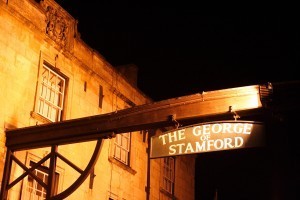 the very respectable nature of its business. During the 18th century, after the Great North Road became a turnpike, The George erected its famous gallows across the road to deter highwaymen rather than encourage them to frequent the hostelry. In those days no fewer than 40 coaches a day passed through Stamford. I enjoyed a drink in the panelled “York Bar” which was once the room where travellers waited for the northern coach. It adds a huge sense of history that both the York and London waiting rooms are still there (and the courtyard where the carriages stopped is now the restaurant – you can see the arch in the photo above!). During the heyday of the coaching trade The George had an assembly room and a ballroom, and must have been a focus of provincial social life in the town and beyond. It would indeed make the most perfect setting for an inn in a Georgian or Regency romance and I know I’ll be drawing on my experience of staying there for future books!
the very respectable nature of its business. During the 18th century, after the Great North Road became a turnpike, The George erected its famous gallows across the road to deter highwaymen rather than encourage them to frequent the hostelry. In those days no fewer than 40 coaches a day passed through Stamford. I enjoyed a drink in the panelled “York Bar” which was once the room where travellers waited for the northern coach. It adds a huge sense of history that both the York and London waiting rooms are still there (and the courtyard where the carriages stopped is now the restaurant – you can see the arch in the photo above!). During the heyday of the coaching trade The George had an assembly room and a ballroom, and must have been a focus of provincial social life in the town and beyond. It would indeed make the most perfect setting for an inn in a Georgian or Regency romance and I know I’ll be drawing on my experience of staying there for future books!
©2013 Nicola Cornick. All Rights Reserved.
.February 22, 2013
Heirs Apparent
Should Lady Mary Crawley be entitled to inherit Downton Abbey? On the Word Wenches we’re chatting about why the boys almost always get the title. Come and tell us what you think about the great inheritance debate here!
about the great inheritance debate here!
©2013 Nicola Cornick. All Rights Reserved.
.February 19, 2013
Ruined Halls
I’m not sure what it is about ruins that attracts me. They can be lonely places. Going around a stately mansion that has been restored to its former glory or has never lost its burnish is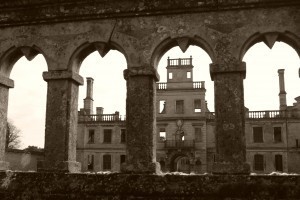 very different from visiting a place where the roof is off and the birds are nesting in the fallen towers. And yet there is something compelling about a ruin. Perhaps it’s glimpsing the ghosts of grandeur past. Perhaps it’s because it leaves room for the imagination to move into the gaps.
very different from visiting a place where the roof is off and the birds are nesting in the fallen towers. And yet there is something compelling about a ruin. Perhaps it’s glimpsing the ghosts of grandeur past. Perhaps it’s because it leaves room for the imagination to move into the gaps.
Last weekend I went to Kirby Hall in Northamptonshire. It was once the home of Sir Christopher Hatton, one of Queen Elizabeth I’s favourites. She apparently took a shine to him after seeing his moves on the dance floor! He developed Kirby in the hope that she would come to visit but sadly she never did. However by the 1690s the beautiful grounds at Kirby Hall were described as “ye finest garden in England.” By the nineteenth century the house had been in decline for a long time, the roof was off, and a shepherd and his sheep lived in a corner of the courtyard.
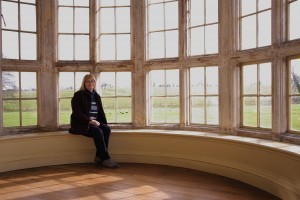 Kirby is a fascinating place to visit. You approach the house through the ruined loggia and courtyard but when you step into the Great Hall it is to find that it is complete, as is the Great Chamber and Great Withdrawing Room upstairs, plus various bed chambers and the Billiards Room, Library and Great Parlour downstairs. So the house is an odd mixture of ruin and roofed, with the west front one of the most elegant pieces of Elizabethan architecture I have seen. The bay windows are so huge that they light and
Kirby is a fascinating place to visit. You approach the house through the ruined loggia and courtyard but when you step into the Great Hall it is to find that it is complete, as is the Great Chamber and Great Withdrawing Room upstairs, plus various bed chambers and the Billiards Room, Library and Great Parlour downstairs. So the house is an odd mixture of ruin and roofed, with the west front one of the most elegant pieces of Elizabethan architecture I have seen. The bay windows are so huge that they light and warm the rooms beautifully. Here I am soaking up the sun on the window seat in one of the ground floor bedrooms, looking out over the gardens and imagining myself as an Elizabethan lady!
warm the rooms beautifully. Here I am soaking up the sun on the window seat in one of the ground floor bedrooms, looking out over the gardens and imagining myself as an Elizabethan lady!
Kirby Hall’s peacocks add the final touch with their eerie cries echoing around the empty walls. There is a real atmosphere about the place. Close your eyes and you can feel the swish of those long skirts and hear the voices as Kirby’s ghosts pass by.
Do you like the atmosphere of a romantic ruin? Do you feel it brings you close to the ghosts of the past?
©2013 Nicola Cornick. All Rights Reserved.
.February 12, 2013
Carvings of the Day!
Today’s post is a little bit eccentric! I’ve been out and about in the last few weeks and I’m posting up a couple of wood carvings I have seen recently, very different from each other, both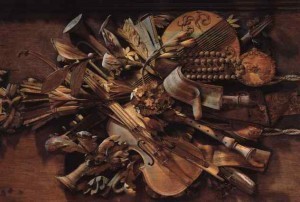 beautiful and meaningful in their own way. The first is from the carved room at Petworth House, a National Trust owned property in West Sussex. I went there to view an exhibition of paintings by JMW Turner and we were lucky enough to be allowed into the rest of the house as well. It’s magnificent and well worth a visit (as is the coffee shop!)
beautiful and meaningful in their own way. The first is from the carved room at Petworth House, a National Trust owned property in West Sussex. I went there to view an exhibition of paintings by JMW Turner and we were lucky enough to be allowed into the rest of the house as well. It’s magnificent and well worth a visit (as is the coffee shop!)
The Carved Room at Petworth features extraordinary wood carving by Grinling Gibbons. This is a detail from it but you can get an idea of the grandeur of the room in this wonderful photograph by Malcolm Bull on Flickr. The original carved room at Petworth was built in about 1690 at a cost of £150. The wood used was lime. I love the intricate detail and all the floral and musical motifs.
 A different carving comes from the Royal Horticultural Society gardens at Wisley, which I visited last week. The RHS was established in 1804 with the name The Horticultural Society of London. Founder members were Sir Joseph Banks and John Wedgwood and the aim of the society was “to collect plant information and encourage the improvement of horticultural practice.” These days the society is famous for its flower shows which started in the late 1820s with floral fetes on the Chiswick estate of the Duke of Devonshire. They were part of the social season and very fashionable. This picture comes from the glorious pinetum at Wisley and is the RHS symbol carved on the end of a tree trunk and captured here in black and white in a rather stunning picture by my talented dh!
A different carving comes from the Royal Horticultural Society gardens at Wisley, which I visited last week. The RHS was established in 1804 with the name The Horticultural Society of London. Founder members were Sir Joseph Banks and John Wedgwood and the aim of the society was “to collect plant information and encourage the improvement of horticultural practice.” These days the society is famous for its flower shows which started in the late 1820s with floral fetes on the Chiswick estate of the Duke of Devonshire. They were part of the social season and very fashionable. This picture comes from the glorious pinetum at Wisley and is the RHS symbol carved on the end of a tree trunk and captured here in black and white in a rather stunning picture by my talented dh!
©2013 Nicola Cornick. All Rights Reserved.
.February 7, 2013
The Regency Country Town
I’m at the UK Regency Authors’ blog today talking about my recent visit to Ashbourne, a country town in Derbyshire. Do you enjoy Georgian and Regency romances set outside London?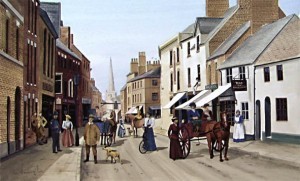 Drop into the blog here and tell us those books you like that are set in a country town!
Drop into the blog here and tell us those books you like that are set in a country town!
©2013 Nicola Cornick. All Rights Reserved.
.February 6, 2013
The Return of the Dandy
We’re chatting about the return of the dandy over on the Word Wench blog today. Back in the 19th century it was Beau Brummell who was the arbiter of men’s style. Now it’s David 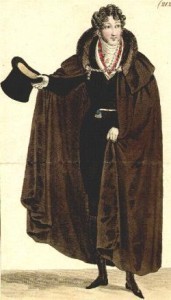 Beckham. So how have today’s dandies drawn on the styles of the past? Drop by the blog to share your style icons with us! Here’s the link.
Beckham. So how have today’s dandies drawn on the styles of the past? Drop by the blog to share your style icons with us! Here’s the link.
©2013 Nicola Cornick. All Rights Reserved.
.February 4, 2013
Richard III – The power of historical myth and mystery
It has been announced today that the bones found under a car park in Leicester are those of King Richard III.
I’ve been a huge fan of Richard III since I was in my teens. I wrote about him in my MA dissertation, which was about the construction of hero myths. For me, Richard III represents a fascinating historical conflict. He is the point at which my impartiality as a historian comes slap up against my instinctive loyalty and liking for Richard III, which is deeply unscholarly and completely subjective.
fascinating historical conflict. He is the point at which my impartiality as a historian comes slap up against my instinctive loyalty and liking for Richard III, which is deeply unscholarly and completely subjective.
I come from Yorkshire. Even though Richard wasn’t a Yorkshireman by birth he spent a lot of his time in the North of England, holding the Lordships of Middleham, Sheriff Hutton and Richmond in Yorkshire. He gained a good reputation as a fair and just President of the Council of the North, and the City of York in particular held him in high esteem. On Richard’s death at Bosworth in August 1485 the City of York took the brave and unusual step of recording their unhappiness at the fact: “Today was our good King Richard piteously slain and murdered to the great heaviness of this city.” This can’t have made them popular with the incoming Tudors but showed how strongly they felt that they risked setting off on the wrong foot with the new administration because Richard was so highly regarded.
I have a framed poster of Richard III with the words “a true Yorkshireman” written on them. Yorkies, as we are known, don’t take everyone to our hearts, so for us to bestow this accolade on a man who was not Yorkshire born is exceptional. It means that we regard Richard as possessing those qualities we admire – loyalty, strength, toughness of character and a certain “Yorkshire grit,” as rugged as the rock the county stands on.
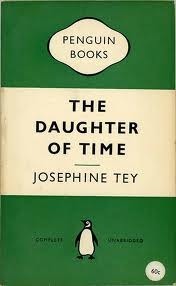 Like many people I discovered Richard III through reading “The Daughter of Time” by Josephine Tey, a great book and a powerful defence of Richard III’s reputation against the slanders of Shakespeare and the Tudor propaganda that blackened his name. When I went to university I studied the 15th century in detail including Richard’s role as a loyal supporter of his brother King Edward IV and also the achievements his own brief reign. I did a huge amount of academic reading on the subject of the Princes in the Tower as well as devouring all the fiction I could find.
Like many people I discovered Richard III through reading “The Daughter of Time” by Josephine Tey, a great book and a powerful defence of Richard III’s reputation against the slanders of Shakespeare and the Tudor propaganda that blackened his name. When I went to university I studied the 15th century in detail including Richard’s role as a loyal supporter of his brother King Edward IV and also the achievements his own brief reign. I did a huge amount of academic reading on the subject of the Princes in the Tower as well as devouring all the fiction I could find.
I think a couple of things come together here to make the story of Richard III such a compelling one. First there is the enduring fascination of a historical mystery. You can’t get much of a bigger mystery than the one of who murdered the Princes in the Tower. For centuries people have argued for and against Richard III being the murderer and unless irrefutable proof comes to light, that is a story that will run and run. Irrefutable facts aren’t the kind of thing one gets often in history; although at school we are so often taught that history is made up of “facts” it isn’t static. History is open to interpretation and new discoveries are being made all the time. So I am not holding my breath that the mystery of the Princes in the Tower will be solved conclusively any time soon.
The other incredibly powerful element in the story of Richard III is the idea of fair play. That he was betrayed on the field of battle leaves a bad taste in the mouth. Then there was the Tudor propaganda. It was of course in the interests of the Tudors to portray Richard III as a monster, the more evil the better. They did a fabulous job of it with Sir Thomas More and William Shakespeare as their star players. But in doing so they, perhaps inevitably, invited a backlash. The depiction of Richard in Shakespeare’s play is a theatrical construct of horror. It’s a powerful fiction. The very power of that monster myth arouses a sense of fair play in those people who know that the “facts” don’t actually fit the fiction and hate to see Richard so maligned.
For me as a Ricardian it is a lovely historical irony that the Tudors worked so hard on their propaganda that they actually helped to create the hero cult of Richard III that exists now. So on a day like this I have several responses to the news that Richard’s body has been found. The trained historian in me is fascinated by the process of discovery and the interpretation of what has been found. The part of me that enjoys studying the way that historical myths are spun is relishing this latest development in Richard’s ongoing hero myth. And the Yorkshire girl whose loyalty to Richard feels like part of her DNA is happy to know that he will be re-buried in Leicester Cathedral (although York Minster would have been better) and thus one ancient wrong at least will be righted.
So on a day like this I have several responses to the news that Richard’s body has been found. The trained historian in me is fascinated by the process of discovery and the interpretation of what has been found. The part of me that enjoys studying the way that historical myths are spun is relishing this latest development in Richard’s ongoing hero myth. And the Yorkshire girl whose loyalty to Richard feels like part of her DNA is happy to know that he will be re-buried in Leicester Cathedral (although York Minster would have been better) and thus one ancient wrong at least will be righted.
©2013 Nicola Cornick. All Rights Reserved.
.January 29, 2013
Forbidden in the UK!
Over on Facebook I have unveiled the cover for the UK edition of Forbidden, which is out in April. If you would like to see it you can click on the link here, or go to the Home page of my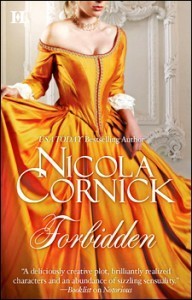 website. Now I have seen both the UK and the US covers (the US one is pictured here) I’m a bit torn over which I like the best. I absolutely love the golden gown on the US edition but this new one is gorgeous too. I guess I should just be grateful that the cover gods keep smiling on me! There’s more exciting news about Forbidden in the UK coming soon. It’s under wraps at the moment, but watch this space!
website. Now I have seen both the UK and the US covers (the US one is pictured here) I’m a bit torn over which I like the best. I absolutely love the golden gown on the US edition but this new one is gorgeous too. I guess I should just be grateful that the cover gods keep smiling on me! There’s more exciting news about Forbidden in the UK coming soon. It’s under wraps at the moment, but watch this space!
©2013 Nicola Cornick. All Rights Reserved.
.January 25, 2013
Happy Burns Night!
Today, 25th January, is the birthday of Scots poet Robert Burns. He was born in 1759 in a small cottage near the Bridge of Doon two miles from the town of Ayr. His birthday is celebrated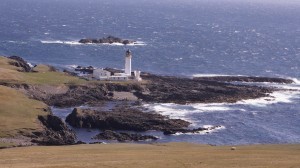 by people of Scots descent all over the world. Tonight in this house we’ll be eating Cock-a-Leekie soup made from chicken and leeks with stewed prunes (delicious!) There is a recipe here if you fancy giving it a try! This is followed by the traditional Burns Night dish of Haggis with Neeps and Tatties (turnips and potatoes). I’ve always found this dish extremely tasty and there is a vegetarian version of haggis you can buy as well.
by people of Scots descent all over the world. Tonight in this house we’ll be eating Cock-a-Leekie soup made from chicken and leeks with stewed prunes (delicious!) There is a recipe here if you fancy giving it a try! This is followed by the traditional Burns Night dish of Haggis with Neeps and Tatties (turnips and potatoes). I’ve always found this dish extremely tasty and there is a vegetarian version of haggis you can buy as well.
The meal begins with the “Selkirk Grace”:
Some hae meat and canna eat,
And some wad eat that want it,
But we hae meat and we can eat,
Sae let the Lord be thankit.
 This is a poem attributed to Burns who is said to have written it on a visit to the Earl of Selkirk. After the grace, the haggis is brought in to a bagpipe accompaniment. (That probably won’t be happening here although I will put on my recording of the beautiful piece Highland Cathedral later in homage.) After toasting the haggis with whisky we’ll be tucking in. Oh, and there will probably be some more malt whisky consumption later!
This is a poem attributed to Burns who is said to have written it on a visit to the Earl of Selkirk. After the grace, the haggis is brought in to a bagpipe accompaniment. (That probably won’t be happening here although I will put on my recording of the beautiful piece Highland Cathedral later in homage.) After toasting the haggis with whisky we’ll be tucking in. Oh, and there will probably be some more malt whisky consumption later!
Wherever you are in the world and whatever you are eating I wish you a very Happy Burns Night! Here are a couple of our Scottish photographs to celebrate. If you’d like to see more, there is a link here to our online Scottish gallery.
©2013 Nicola Cornick. All Rights Reserved.
.January 21, 2013
To Sleep, perchance to dream…
Do you sleep like a log (or a happy puppy) or are you an insomniac? We’re chatting about sleep today on the Word Wench blog. Come and share your experiences with us! 
©2013 Nicola Cornick. All Rights Reserved.
.


